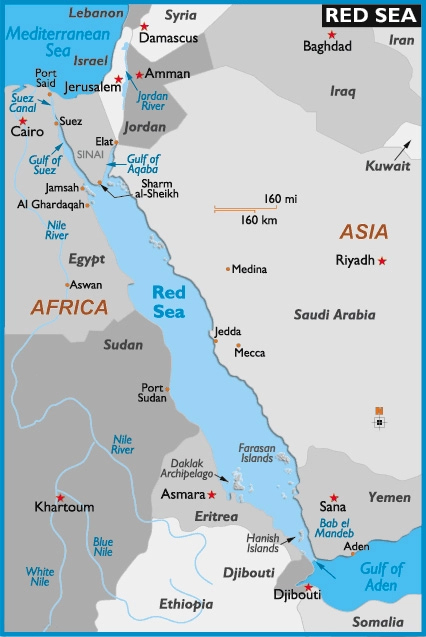Red Sea | 08 Apr 2021
Why in News
An Iranian freighter was hit by Israel in the Red Sea in retaliation for past Iranian strikes on its vessels. The blast struck the Iranian commercial vessel MV Saviz off the coast of Djibouti.
- The attack came as Iranian officials gathered in Vienna to negotiate the restoration of a 2015 deal Joint Comprehensive Plan of Action (JCPOA) that was designed to curb Iran’s nuclear activities.
Key Points
- Red Sea:
- Location:
- The Red Sea is a semi-enclosed tropical basin, bounded by northeastern Africa, to the west, and the Arabian peninsula, to the east.
- The elongated and narrow-shaped basin extends between the Mediterranean Sea, to the north-west, and the Indian Ocean, to the south-east.
- At the northern end, it separates into the Gulf of Aqaba and the Gulf of Suez, which is connected to the Mediterranean Sea via the Suez Canal.
- At the southern end, it is connected to the Gulf of Aden, and the outer Indian Ocean, via the Strait of Bab-el-Mandeb.
- It is surrounded by desert or semi-desert areas, with no major freshwater inflow.
- Formation:
- The Red sea acquired its present shape over the past 4 to 5 million years, by slow seafloor spreading, a fact that makes it a geologically recent opening and one of the youngest oceanic zones on Earth.
- Today, the basin continues to widen at a rate of 1-2 cm per year
- Biodiversity:
- The unique habitats of the Red sea support a wide range of marine life, including sea turtles, dugongs, dolphins and many endemic fish species.
- Coral reefs mainly extend along the northern and central coasts, and decrease in abundance towards the southern region, as coastal waters become more turbid.
- The Reason why it is called Red Sea:
- There are various theories as to how the name came about, with the most popular being a reference to the seasonal blooms of Trichodesmium erythraeum (a red-colored algae) near the water’s surface.
- Other scholars believe it is linked to the way Asiatic languages often use colors to refer to cardinal directions, with “red” referring to “south” just as the Black Sea may be referring to the north.
- Location:
Joint Comprehensive Plan of Action
- In 2015, Iran with the P5+1 group of world powers - the US, UK, France, China, Russia, and Germany agreed on a long-term deal on its nuclear programme.
- The deal was named as Joint Comprehensive Plan of Action (JCPOA) and in common parlance as Iran Nuclear Deal.
- The deal came after years of tension over Iran's alleged efforts to develop nuclear weapons.
- Iran insisted that its nuclear programme was entirely peaceful, but the international community did not believe that.
- Under the JCPOA, Iran agreed to limit its nuclear activities by stopping uranium enrichment and allowing the international agencies to inspect its nuclear facilities in return for the lifting of economic sanctions.
- However, in May 2018, the USA pulled out of the JCPOA and threatened to impose sanctions on Iran and on nations doing a significant amount of trade with Iran.

